If you’re looking for a litter box for multiple cats, there are a few factors you need to consider before choosing the right one. The first thing you need to think about is the size of the litter box. It should be large enough to accommodate all of your cats comfortably. You also need to consider the type of litter you want to use, as some litter boxes are only suitable for certain types of litter.
Another important factor to consider is the design of the litter box. A hooded litter box may be more suitable for cats that like privacy, while an open litter box may be better for cats that prefer an open space. You also need to think about the cleaning process, as some litter boxes are easier to clean than others.
Before making any decisions, ask yourself some important questions. Can the litter box hold multiple cats at the same time? Does it have any features such as odor control or self-cleaning? Is it durable enough to withstand the wear and tear of multiple cats using it? By taking these factors into consideration, you’ll be able to choose the right litter box for your feline friends.
10 Best Litter Box Multiple Cats
| # | Product Image | Product Name | Product Notes | Check Price |
|---|---|---|---|---|
|
1
|
The product is ideal for cat owners who want a self-cleaning litter box with app control, safe alerts, and health monitoring.
|
|
||
|
2
|
The product is ideal for cat owners who want a large, self-cleaning litter box with smart features and odor control.
|
|
||
|
3
|
Ideal for multi-cat households, this self-cleaning litter box offers strong odor control, safety protection and can be controlled via an app.
|
|
||
|
4
|
This product is ideal for indoor cat owners with multiple cats who want an easy-to-clean and enclosed litter box.
|
|
||
|
5
|
The product is ideal for cat owners who want a hassle-free, odor-controlled, and health-monitored litter box for multiple cats.
|
|
||
|
6
|
The product is ideal for a family with multiple cats and wants an automatic, remotely controlled, and odor suppressing litter box.
|
|
||
|
7
|
The product is ideal for cat owners who want a self-cleaning litter box with app control and a large capacity.
|
|
||
|
8
|
This product is ideal for cat owners who want a hands-free, easy to clean litter box that doesn't require expensive refills.
|
|
||
|
9
|
This product is ideal for pet owners looking for a hands-free and odor-controlled solution to litter box maintenance.
|
|
||
|
10
|
This product is ideal for cat owners who want a self-cleaning litter box that eliminates odors and works with clumping litter.
|
|
1. Hillpig Smart Cat Litter Box: App-Controlled & Safe!
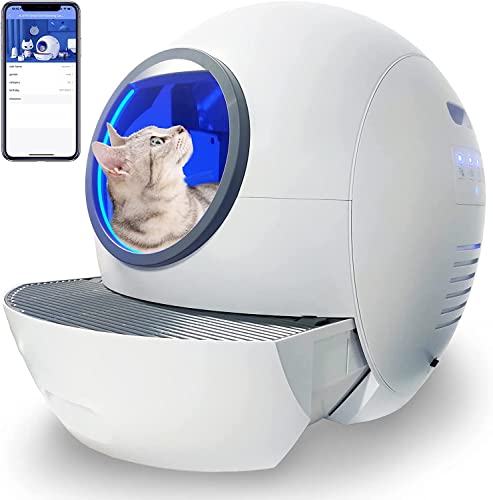
The Hillpig self-cleaning cat litter box is a smart, simple, and safe solution for cat owners who want to keep their homes clean and their cats healthy. With an APP control feature that can be accessed anywhere and anytime via 2.4Ghz Wi-Fi, this litter box is easy to manage. The automatic cleaning system dumps the waste into the trash bag after the cats leave the litter box, and the purple light is turned on until the next time the cats use the box. The built-in LED safe alerts give you information about the operating status, and multiple secure sensors ensure that emergency braking is activated to protect your cats in case of any issues.
The litter box also has a health monitor feature that syncs data to your phone, allowing you to track the times of use and the litter capacity. This helps you monitor your cats' health status at all times. The newest self-clean design, which doesn't involve a rotating filter, ensures that the waste doesn't stick to the machine and become smelly. The drawer footboard makes it easy for cats to get in and out of the litter box, and it also collects the litter brought out by the cats, preventing more chaos in the living room.
The Hillpig automatic cat litter box is extra-large, with a 60L capacity that fits multiple cats weighing from 3.3lb to 28lb. The waste container can go up to 15 days without scooping for one cat. The litter box is compatible with all kinds of clumping cat litter, including plant litters, mixed litters, bentonite litters, and more.
Hillpig offers a 12-month guarantee and brand service. If you have any issues, please contact customer support for 24/7 assistance before returning the product.
- APP control feature for easy management
- Automatic cleaning system for hassle-free cleaning
- Built-in LED safe alerts for operating status
- Health monitor feature to track usage and capacity
- Newest self-clean design to prevent waste from sticking
- Drawer footboard to prevent litter messes in the living room
- Extra-large size for multiple cats
- Compatible with all kinds of clumping cat litter
- 12-month guarantee and brand service
2. Kungfupet Smart Self-Cleaning Litter Box For Cats
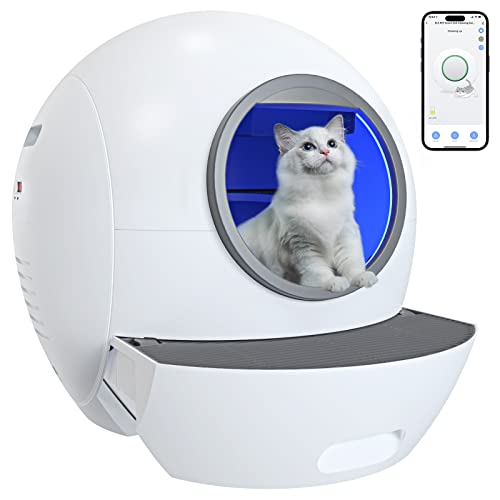
The KungFuPet self-cleaning cat litter box is a revolutionary product that allows cat owners to release their hands from the tedious task of cleaning the litter box. The litter box comes with an app-controlled remote or one-key control that clumps and separates cat excrement from clean cat litter automatically. It also tracks cat usage time and trash volume to help cat owners monitor their cat's health. The upgraded odorless technology effectively eliminates unpleasant odors and the self-cleaning system automatically turns on the light to remove the smell after cleaning. The litter box also features an artificial arm shovel and anti-stick technology that prevents cat litter from sticking to the box and saves more cat litter. The litter box is suitable for most bentonite litter (others should be shorter than 5mm) and requires at least 15 minutes for cleaning. The litter box has a 60L large capacity and is suitable for multiple cats from 3.3lbs to 25lbs. The outer stairs for self-cleaning cat litter boxes can help reduce litter cats dropping when they go out. KungFuPet provides 1-year brand warranty service and their support team is available 24/7 to answer any questions or concerns.
- App-controlled remote or one-key control for easy operation
- Upgraded odorless technology effectively eliminates unpleasant odors
- Artificial arm shovel and anti-stick technology saves more cat litter
- Suitable for most bentonite litter (others should be shorter than 5mm)
- 60L large capacity and is suitable for multiple cats from 3.3lbs to 25lbs
- Outer stairs for self-cleaning cat litter boxes can help reduce litter cats dropping when they go out
- KungFuPet provides 1-year brand warranty service
- Support team is available 24/7 to answer any questions or concerns
- – Requires at least 15 minutes for cleaning
- – Replacement rake may be needed, contact support for assistance
- – Cat litter should not exceed the maximum daily storage capacity to ensure that the rake does not work
3. Smartscoop Xl – The Ultimate Self-Cleaning Litter Box
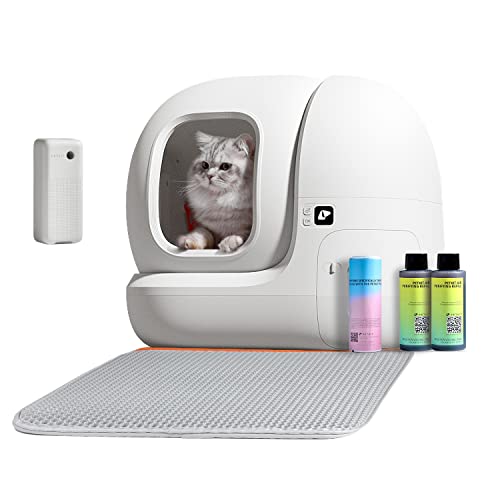
The PETKIT PURAMAX is a self-cleaning cat litter box that offers an innovative solution for cat owners. It is equipped with a 2.4GHz Wi-Fi connection, which allows you to control the litter box from anywhere, at any time, using the PETKIT app. The xSecure system ensures the safety of your cat, with an infrared sensor, weight sensors, remote alerts, an accident protection system, and smart detections. This system ensures that the litter box automatically pauses when your cat approaches or when there is a change in weight. This feature offers peace of mind to cat owners who are worried about their cat's safety.
The PETKIT PURAMAX is designed to help you keep track of your cat's health. The smart sensors enable you to monitor your cat's weight, usage times, duration of use, and litter capacity. This information is available via the PETKIT app, enabling you to keep track of your cat's health at all times.
The PETKIT PURAMAX offers an auto-cleaning feature with three alternative modes; auto-cleaning mode, scheduled-cleaning mode, and manual-cleaning mode. You can set the device to scheduled or automatic cleaning mode via the app, and the PURAMAX automatically removes waste as soon as your cat leaves the litter box. To activate the manual-cleaning mode, simply tap the 'Clean' button via the PETKIT app or press the button on the PURAMAX to clean the cat litter box. With the extra-large capacity of the 76L cylinder, the PURAMAX offers up to 15 days of scooping-free usage for one cat. This feature makes it an ideal solution for cat owners who are looking for a hassle-free cat litter box.
The PETKIT PURAMAX is made of TPE rubber, which prevents soft stools from sticking to the cat litter box, keeping your cat's toilet clean at all times. The detachable deodorizer, PURA AIR smart spray, is an added feature of the PURAMAX. It is designed to remove odors, ensuring that your home remains fresh and clean. You can set the device to scheduled or automatic odor removal via the app, and manually press the PURAMAX button to remove odors. The modular design, detachable cylinder, TPE rubber, and filter allow for easy cleaning and maintenance of the litter box.
The PETKIT PURAMAX comes with a cat litter mat, one roll of trash bags, two bottles of air purifying refills, US adapter, stickers, and an English user manual. This cat litter box is suitable for cats weighing between 3.5lb to 18lb and over six months old. The spacious interior offers enough room for your cat to move around comfortably. The PETKIT PURAMAX is an excellent investment for cat owners who are looking for a smart, safe, and hassle-free cat litter box.
- Equipped with a 2.4GHz Wi-Fi connection, allowing you to control the litter box from anywhere, at any time, using the PETKIT app
- The xSecure system ensures the safety of your cat, with an infrared sensor, weight sensors, remote alerts, an accident protection system, and smart detections
- Extra-large capacity of the 76L cylinder offers up to 15 days of scooping-free usage for one cat
- The PURAMAX is made of TPE rubber, which prevents soft stools from sticking to the cat litter box, keeping your cat's toilet clean at all times
- The detachable deodorizer, PURA AIR smart spray, removes odors, ensuring that your home remains fresh and clean
- The modular design, detachable cylinder, TPE rubber, and filter allow for easy cleaning and maintenance of the litter box
4. Odor-Free Xxl Cat Litter Box.
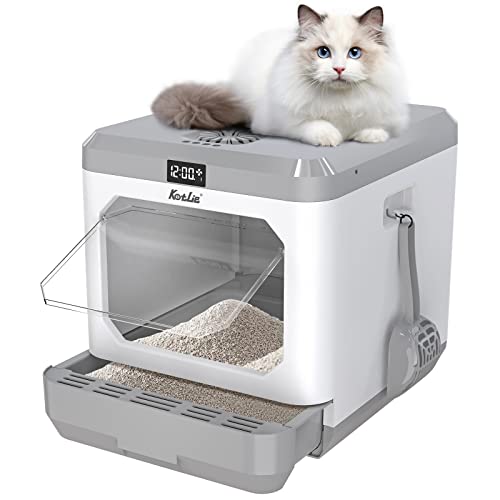
Eliminate unpleasant odors from your cat's litter box with the Kotlie enclosed litter box with a lid and advanced plasma deodorization system. This innovative technology not only eliminates the odors but also purifies the air, ensuring a fresh and clean environment for you and your pets. The spacious and comfortable litter box is designed to accommodate cats weighing from 2.2lb to 22lb, making it ideal for households with multiple cats. The pull-out drawer design of the Kotlie covered litter box makes it easy to clean, while the 12L capacity drawer reduces the frequency of litter replacement. The fully enclosed design of the litter box protects your cat's privacy and prevents litter from being tracked outside the box, ensuring a clean and hygienic home. The Kotlie cat litter box with lid can be easily assembled within minutes and comes with an extra high-quality cat litter scoop and silicone cat litter mat. Buy the Kotlie smart deodorized cat litter box today and say goodbye to unpleasant odors for good!
The Kotlie enclosed litter box with lid and advanced plasma deodorization system is a cost-effective solution that saves you money in the long run. With no need to change filters or invest in expensive self-cleaning products, the Kotlie deodorizing kitty cat litter box provides better odor control compared to litter boxes with deodorizers or filters. The anti-leakage pedal also prevents litter from being tracked outside the box, making it easy to maintain a clean and hygienic home.
If you have any issues, please reach out to the Kotlie customer service team, who will provide a satisfactory response within 24 hours.
- Advanced plasma deodorization system eliminates unpleasant odors and purifies the air
- Spacious and comfortable litter box accommodates cats weighing from 2.2lb to 22lb
- Pull-out drawer design makes it easy to clean and maintain
- Fully enclosed design protects your cat's privacy and prevents litter from being tracked outside the box
- Cost-effective solution that saves you money in the long run
- Anti-leakage pedal ensures a clean and hygienic home
5. Luxurypro Self-Cleaning Cat Litter Box With Health Monitoring
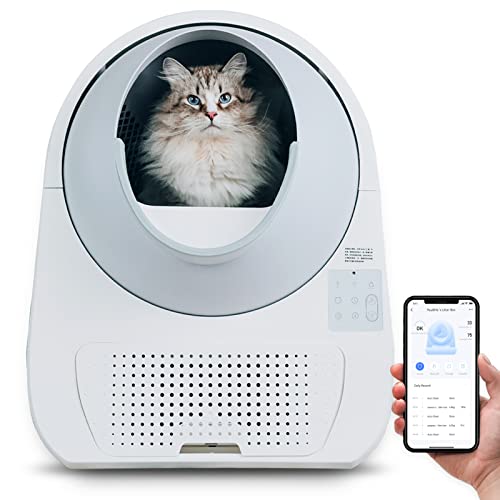
The CATLINK automatic cat litter box is the perfect solution for multi-cat families. With its advanced technology, it can detect and recognize different cats and record their toilet information. The Catlink App allows cat parents to check the ambient temperature and humidity, and remotely control the self-cleaning litter box at any time. The app also provides a 24-hour record and 7-Day/12-Month health graphics report to keep track of the cats' health. This litter box is 100% safe for cats, thanks to its integrated device of radars, infrared sensor, gravity sensor, anti-pinch infrared sensor, self-detection, abnormal alerts through the app, ventilated and inverted triangle stable structure design. The litter box has four cleaning modes: Auto Mode, Manual Mode, Timer Mode, and Empty Mode, which can be controlled remotely through the app or panel. The double odor removal feature uses a re-chargeable odor purifier (not included) and carbon filter to effectively eliminate unpleasant odors, formaldehyde, and ammonia. The thoughtful design includes a built-in smart illumination feature for elderly cats with poor eyesight, a Do Not Disturb mode for a quiet environment, and a panel lock feature to prevent accidental touch by pets or children. The CATLINK automatic litter box is 23.62*22.93*27.95 inches in size, with a 57L box cabin capacity and a 13L waste box capacity. It is suitable for cats weighing from 3.3lb to 22lb and is only compatible with clumping cat litter. The cat litter should not exceed the max level line mark in the cylinder box. In case of any issues, customer service can be contacted with the serial and order number.
- Advanced technology can detect and recognize different cats and record their toilet information.
- Catlink App allows cat parents to check ambient temperature and humidity and remotely control the litter box.
- Provides a 24-hour record and 7-Day/12-Month health graphics report to keep track of cats' health.
- 100% safe for cats due to integrated device of radars, infrared sensor, gravity sensor, anti-pinch infrared sensor, self-detection, abnormal alerts through the app, ventilated and inverted triangle stable structure design.
- Four cleaning modes: Auto Mode, Manual Mode, Timer Mode, and Empty Mode, which can be controlled remotely through the app or panel.
- Double odor removal feature uses a re-chargeable odor purifier (not included) and carbon filter to effectively eliminate unpleasant odors, formaldehyde, and ammonia.
- Thoughtful design includes a built-in smart illumination feature for elderly cats with poor eyesight, a Do Not Disturb mode for a quiet environment, and a panel lock feature to prevent accidental touch by pets or children.
- Suitable for cats weighing from 3.3lb to 22lb and is only compatible with clumping cat litter.
- Large 57L box cabin capacity and 13L waste box capacity make it perfect for multi-cat families.
- – Not recommended for underweight kittens.
- – Re-chargeable odor purifier not included.
6. Smartpurr Cat Box: Advanced Self-Cleaning, Odor Control
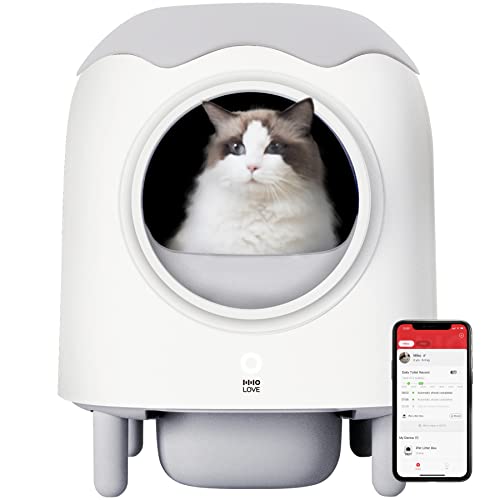
The Automatic Cleaning Litter Box is a smart and efficient way to keep your cat's litter box clean. It automatically cleans up the excrement after the cat has finished defecating and detects when the cat has left the safety to set the delayed cleaning time by APP. The excrement is separated from the clean cat litter in the litter box, which can be easily replaced when it is full. The litter box is designed to support a variety of cat litter, including bentonite sand, mixed mineral sand, plant sand, and other long and short coarse and fine cat litter (excluding crystal cat litter).
The Intelligent Peace of Mind feature ensures the safety of your cat while using the litter box. The microwave radar 360-degree defense automatically detects cats approaching and stops the machine. The heat sensing inside the bucket stops the machine when the cat is inside the bucket. The infrared sensing at the bottom of the bucket stops the machine from returning if the cat is caught, and notifies you by APP immediately.
The Dual Odor Purification feature helps to keep the litter box odor-free. The intelligent deodorizer automatically adjusts the number and length of deodorization according to the cat's toileting record, or can be controlled with the APP's one-key deodorization. The toilet bin is equipped with a plant essential oil deodorizing box to further reduce odor.
The APP Remote Monitoring feature allows you to control the litter box with one key deodorization, one key poop removal, and one key litter replacement function. It also records your cat's toileting habit data to monitor their safety and health. You will be notified if the litter box is full or if there is an abnormal situation.
The Automatic Cleaning Litter Box comes with a 1-year warranty. If you have any questions or concerns during the usage of the product, the customer service is always available to provide you with a satisfactory solution.
- Automatically cleans up the excrement and detects when the cat has left the safety
- Supports a variety of cat litter, except crystal cat litter
- Intelligent Peace of Mind feature ensures the safety of your cat while using the litter box
- Dual Odor Purification feature helps to keep the litter box odor-free
- APP Remote Monitoring feature allows you to control and monitor the litter box with ease
- Comes with a 1-year warranty
- – May not work well with crystal cat litter
7. Turquoise Green Smart Cat Litter Robot
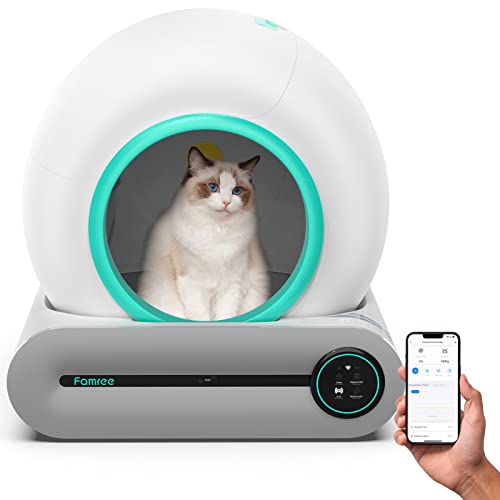
Famree's All-in-One Waste Disposal System is the ultimate solution for cat safety. It is designed to replace traditional drawer-style collection methods and decrease the risk of cat entrapment to 0%. This unique litter box and waste bin combination has a patented integrated structure that ensures the safety of your cat.
With a collection bin capacity of 2.4 Gal/9L, this dynamic collection system has enough space to sustain a 13 lb. cat for 15 days of usage. You can travel confidently and not worry about your cat being home alone. The waste bin's door remains closed after the poop has fallen in, reducing the spread of odors with its refrigeration grade odor-elimination system that works without any chemical components.
Famree's All-in-One Waste Disposal System is equipped with four weight sensors and infrared sensors that tell the device when to stop rotating and when your cat is close. The intelligent health monitoring system updates information about your cat's frequency, time, and weight through the mobile app. The overall size of this system measures 18.9"*20.5"*19.9", with a volume of 4.5 cubic feet, providing your cat with 17.2 Gal/65L of toilet space, which can accommodate a maximum weight of 17.6lb/8kg cat use.
You can experience even more control with Famree's mobile app and manual control. Four cleaning modes, including Automatic Sensor Cleaning, Timed Cleaning, One-click Cat Litter Change, and Clean Smell Mode, are available at your fingertips. The app allows you to monitor your cat's health, control the cleaning process remotely, and receive alerts when the waste bin is full.
In summary, Famree's All-in-One Waste Disposal System is the ultimate cat safety solution. It provides a dynamic collection system, refrigeration grade odor-elimination, intelligent health monitoring system, better space utilization, and manual and app control. Say goodbye to traditional litter boxes and hello to a cleaner, safer, and smarter way of caring for your cat.
- Decreases the risk of cat entrapment to 0%
- Enough capacity to sustain a 13 lb. cat for 15 days of usage
- Refrigeration grade odor-elimination system that works without any chemical components
- Equipped with four weight sensors and infrared sensors for intelligent health monitoring
- Better space utilization providing your cat with 17.2 Gal/65L of toilet space
- Four cleaning modes, including Automatic Sensor Cleaning, Timed Cleaning, One-click Cat Litter Change, and Clean Smell Mode
- Manual and app control for added flexibility and convenience
- – May be more expensive than traditional litter boxes
8. Smart Scoop Auto Litter Box: Clean, Hands-Free!
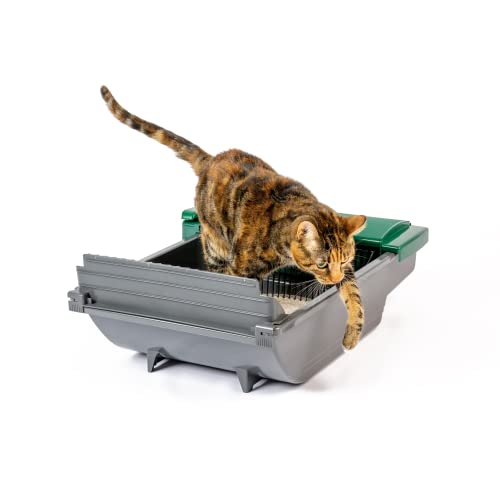
The hands-free waste disposal self-cleaning cat litter box is an excellent alternative to traditional cat litter boxes. The product comes with a smart sensor that triggers the cleaning cycle, making it convenient for cat owners. The package includes a one-month supply of no-touch plastic cat litter bags that make using the cat litter box hassle-free.
This automatic cat litter box has an angled deflector with fins and raised height to ensure cat litter clumps remain inside the litter pan, preventing messes and odors. The revolutionary carbon zeolite technology eliminates cat odors, keeping your home smelling fresh and clean. It's recommended to use lightweight or less dense cat litter for best results.
The litter box is convenient, cost-effective, and easy to clean. You can choose your preferred lightweight clumping cat litter, which reduces waste and makes it budget-friendly, unlike other self-cleaning litter boxes that require specialized or costly crystal cat litter. Cleaning and maintenance are easy with modular components that can be disassembled and cleaned with pet-friendly soap and water.
This automatic litter box is quieter than other leading brands, making it four times quieter than the competition. The noise level is low, which means there will be no household disruption for your cats or you. This perfect self-cleaning litter box is suitable for up to two cats.
Additionally, the product comes with a one-year limited warranty, and the electronic automatic cat litter box ships in a brown drop-ship box. It's not recommended for kittens under six months old. The customer care team is always ready to assist with any issues that may arise.
- Smart sensor for triggered activation of cleaning cycle
- Eliminates cat odors with carbon zeolite technology
- Easy to clean with modular components
- Budget-friendly with the ability to choose preferred cat litter
- Four times quieter than other leading brands
- One-year limited warranty
- – Not recommended for kittens under six months old
9. Crystal Clean Cat Box – No More Scooping!
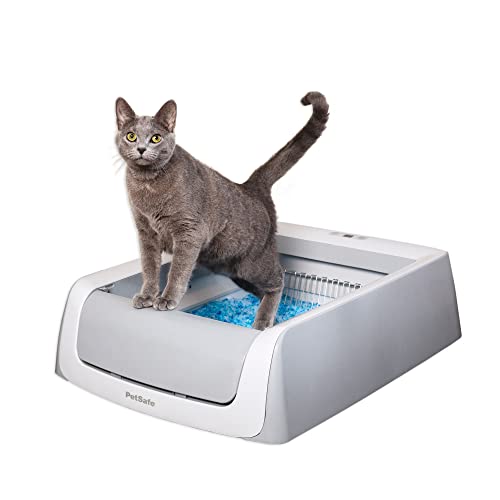
Say goodbye to litter box scooping, cleaning, and refilling for weeks with the automatic litter box that removes waste effectively. The crystal litter included in the disposable ScoopFree litter tray absorbs urine and dehydrates solid waste in minutes, providing unbeatable odor control that is five times better than traditional clumping litter. Additionally, the low-tracking crystals are 99% dust-free and do not stick to your cat's paws, which eliminates messy floors that require constant cleaning.
The disposable trays come with a plastic lining that protects against leaks, ensuring your floors remain clean. To dispose of the waste, all you have to do is remove the tray and throw it away. The tray includes a lid that makes it easy to handle and dispose of the waste quickly.
The automatic litter box also has a health counter and motion sensors that monitor your cat's health by keeping track of how many times they use the box. For optimal performance, use ScoopFree Premium Crystal Litter with your automatic litter box, as it is specially designed for this litter box and provides five times better odor control than traditional clumping litter.
- Eliminates the need for litter box scooping, cleaning, and refilling for weeks
- Provides unbeatable odor control that is five times better than traditional clumping litter
- Low-tracking crystals are 99% dust-free and do not stick to your cat's paws
- Disposable trays come with a plastic lining that protects against leaks
- Health counter and motion sensors monitor your cat's health by keeping track of how many times they use the box
- Easy to dispose of waste by simply removing the tray and throwing it away
- – Only works optimally with ScoopFree Premium Crystal Litter
10. Freshpurr Automatic Litter Box – Smart & Self-Cleaning
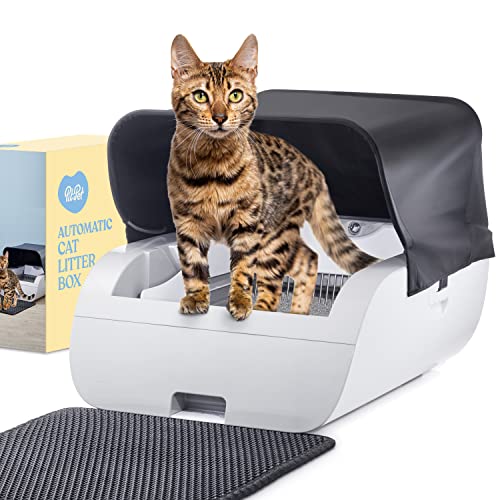
Say goodbye to the tedious task of scooping your cat's litter with this innovative self-cleaning litter box. Equipped with a powerful automatic raking system, the litter box eliminates the need for nightly scooping and can go weeks without needing to be emptied. The package includes a litter mat, shovel, and roll of plastic for added convenience.
The litter box also boasts a powerful deodorizer that contains odors and prevents them from spreading throughout your home. When in deodorizing mode, the display panel illuminates an 'eliminate odor' icon so you know it's working.
Cat owners can rest easy knowing their pet's safety is a top priority with this litter box. a built-in safety sensor ensures that the raking process stops immediately if your cat enters the box, protecting them from harm. The motion sensor icon lights up to indicate when the cleaning mode automatically activates 20 minutes after your cat leaves.
This self-cleaning litter box is also a money-saver as it can be filled with any clumping litter your cat prefers, eliminating the need for expensive specialty brands. Unused litter is automatically scooped into a recovery receptacle for reuse.
Designed for ultimate convenience, this litter box is compatible with any clumping litter except for crystals or column tofu. It operates on a built-in 4000 MAH battery and can run for up to 10 days without any power source, making it ideal for both indoor and outdoor use. The hood provides your cat with privacy, and the litter mat, which features two layers, captures more litter, so you have less to clean up off of your floors.
- Self-cleaning feature eliminates the need for nightly scooping
- Powerful deodorizer keeps odors contained
- Built-in safety sensor protects your cat from harm
- Money-saving as it can be filled with any clumping litter
- Compatible with any clumping litter except for crystals or column tofu
- Operates on a built-in 4000 MAH battery and can run for up to 10 days without any power source
- Waterproof and leakproof construction
- Includes litter mat for added convenience
- Suitable for indoor and outdoor use
- Provides cat with privacy
- – May not be suitable for cats who are sensitive to noise
- – Some cats may not like the automatic raking system
- – Requires periodic maintenance to ensure proper functioning
Best Litter Box Multiple Cats FAQs
How do I prevent litter box territorial issues among multiple cats?
Litter box territorial issues can be a common problem when you have multiple cats in your home. The best way to prevent this issue is to provide each cat with their own litter box. Experts recommend having one litter box per cat, plus one extra. So, if you have three cats, you should have four litter boxes in different locations around your home.
Make sure the litter boxes are in quiet and private areas of your home, away from high traffic areas, and that they are cleaned regularly. Cats are clean animals and they prefer a clean litter box. If they feel that the litter box is dirty, they may start avoiding it, leading to territorial issues.
It's also important to monitor your cats' behavior and watch for signs of aggression or discomfort around the litter boxes. If you notice any problems, try to address them immediately. You can also consider using pheromone sprays or diffusers to help calm your cats and reduce stress levels.
Overall, providing multiple litter boxes and keeping them clean is key to preventing litter box territorial issues among multiple cats. With a little effort and patience, you can ensure that all your cats are happy and comfortable in your home.
How many litter boxes do I need for multiple cats?
A general rule of thumb when it comes to litter boxes for multiple cats is to have at least one box per cat, plus an additional box. So, if you have two cats, you should have three litter boxes. This ensures that each cat has access to a box when they need it and helps to prevent territorial issues or litter box avoidance.
It's also important to consider the size and placement of the litter boxes. They should be large enough for your cats to comfortably use and placed in different areas of your home to provide easy access. Additionally, keeping the boxes clean and scooped regularly can help prevent any issues and keep your cats happy and healthy.
If you have any specific concerns or questions about litter boxes and multiple cats, it's always best to consult with your veterinarian or a feline behavior specialist for personalized advice.
How often should I clean the litter boxes for multiple cats?
As a pet owner, it is important to maintain a clean and healthy environment for your furry companions. When it comes to multiple cats, the litter box should be cleaned more frequently than for a single cat. Ideally, a litter box should be cleaned at least once a day for each cat. This means if you have two cats, you should clean their litter boxes twice a day. This will prevent the buildup of urine and feces, which can cause unpleasant odors and potential health issues for your cats.
If you’re unable to clean the litter boxes twice a day, consider investing in self-cleaning litter boxes or using a litter box with a larger capacity. Additionally, make sure to use high-quality litter and to replace it completely at least once a week. By maintaining a clean litter box, you can ensure the health and happiness of your beloved cats.
Should I use one large litter box or multiple smaller ones for multiple cats?
When it comes to providing litter boxes for multiple cats in your household, it is generally recommended to use multiple smaller boxes instead of one large litter box. This is because cats are territorial animals and may feel uncomfortable sharing a litter box with other cats. Using multiple smaller boxes can also prevent overcrowding and competition for the litter box, which can lead to inappropriate elimination outside of the box.
The general rule of thumb is to have one litter box per cat, plus an additional box. For example, if you have two cats, you should provide three litter boxes. Additionally, it is important to place the litter boxes in different locations throughout your home to give each cat their own private space.
Keep in mind that the size and type of litter box you choose is also important. Make sure the litter box is large enough for your cat to comfortably turn around in and has a low entrance for easy access. Consider using unscented, clumping litter for easier cleaning and to avoid any potential respiratory issues for your cats.
Overall, providing multiple smaller litter boxes is the best way to ensure a clean and comfortable environment for all of your feline friends.
What type of litter is best for multiple cats?
As a cat owner, it is important to choose the right type of litter for your feline friends. When it comes to multiple cats, it is even more important to choose a litter that can accommodate the needs of all your cats. There are several types of litter available in the market, but the best one for multiple cats is clumping litter.
Clumping litter is made of bentonite clay, which forms tight clumps when it comes in contact with moisture. This makes it easier to clean and maintain the litter box. Clumping litter also has excellent odor control, which is essential when you have multiple cats. Some brands also offer multi-cat formulas that are specifically designed for households with more than one cat.
Another important factor to consider when choosing litter for multiple cats is the size of the litter box. It is recommended to have one litter box per cat, plus an extra one. This ensures that each cat has access to a clean litter box and helps prevent territorial issues.
In conclusion, clumping litter is the best option for multiple cats. It provides easy cleanup, excellent odor control, and is available in multi-cat formulas. Remember to provide enough litter boxes for all your cats to avoid any problems.

